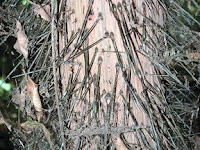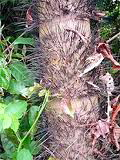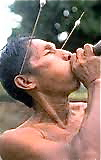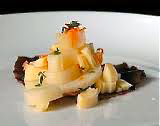 |
| Spiny Astrocaryum palm |
A virote was originally a crossbow bolt, brought to South America by the conquistadores. The Spanish term was then applied to the darts shot by the Indians with a blowgun. These darts were made primarily from two sources — from the spines of any of the spiny Bactris or Astrocaryum palms or from any of several Euterpe palms, whose very hard wood is used to make both bows and arrows. My jungle survival instructor, Gerineldo Moises Chavez, could whittle a usable dart from the wood of a Euterpe palm with his machete in less than a minute.
 |
| Spiny Bactris palm |
All three genera are known rather indiscriminately as chonta, and the term chonta is often used as a synonym for virote. Thus, too, the verb chontear means to cast magic darts at a victim; a chontero is a sorcerer who inflicts harm with magic darts. Euterpe and Bactris species, too, are a primary source of edible palm hearts, also called chonta; palm hearts make a delicious salad. The Shuar term uwishín, shaman, may derive from uwí, the spiny Bactris palm, which they also know as chonta; the Shuar thus often use the term chonta as a synonym for the Shuar word tsentsak, magic dart.
 |
| Virotes |
The virtually universal method of inflicting magical harm in the Upper Amazon is to project a pathogenic object into the body of the victim. Among mestizos and a number of indigenous peoples this projectile is conceptualized primarily as a virote, a magic dart. This intrusion causes acute and painful sickness, which can kill within a few days. To understand the power of the virote, we can turn to poet César Calvo, who writes that it is a “very small poisoned dart, capable of abandoning and resuming its material shape in order to traverse any distance; any time; any wall, shield, or protection; to nail itself in enemy flesh and to reach the target selected by the sorcerer who gave it form and then animated that form, endowing it with destiny and transcendence.”
 |
| Darts in the phlegm of a Shipibo sorcerer (detail from a painting by Pablo Amaringo) |
But these pathogenic projectiles can also be — varying in different cultures and under different circumstances — tufts of hair, tiny stones, quartz crystals, fur, insects, beetles, scorpions, snake fangs, stingray stings, the beaks of certain birds, porcupine quills, bats, toads, snakes, monkey teeth, sharp-pointed bones, a piece of a knife, a bead, stinging caterpillars, crystal arrows, or razor blades. A Cashinahua claimed to have seen the muka, the bitter shamanic substance, within the body of a shaman — a small ball of poison, a small piece of a knife, a small wood splinter, a bead.
 |
| Insects, spiders, and scorpions in the phlegm of a Cocama sorcerer (detail from a painting by Pablo Amaringo) |
These pathogenic objects are kept within the shaman’s body, often embedded in some phlegm- or saliva-like substance. The projectiles are also in some sense autonomous, alive, spirits, sometimes with their own needs and desires, including a need for nourishment, often supplied by tobacco, or a need to consume human flesh. The darts, and their slimy or sticky carrier, are defensive as well as offensive; they can prevent enemy darts from entering the body, or absorb them, acquire their power, or project them back to the one who sent them. The same darts that are used in attack sorcery are most effective in protection against attack. The primary cure for the intrusion of such a magical object into the body is its extraction: the healing shaman sucks it out and disposes of it.
A painting by Pablo Amaringo shows the phlegm of two sorcerers — a Shipibo chontero, who inflicts harm with darts made from the thorns of spiny palms, the fangs of snakes, the beaks of birds, porcupine quills; and a Cocama sorcerer, whose phlegm contains snakes, scorpions, bats, rays, toads, which he sends to inflict harm.
 |
| Palm heart (chonta) salad |
Among mestizos and other peoples, these projectiles are taken from the phlegm and shot into the victim by blowing with the mouth, either with or without tobacco smoke. Other sorcerers may project them through their arms and out an opening in their hands; or they may be carried by an animal or bird controlled by the sorcerer, given in food or drink, or left on the ground to be stepped on. Yagua shamans keep their darts in their stomach — some claim to have as many as a thousand — and project them by rubbing their arm and shoulder progressively toward their hand; the dart is extracted by blowing with tobacco smoke, propelled with the aid of magic gloves, and carried to its destination by the spirit allies.
Remember that the next time you are eating an expensive heart-of-palm salad.

- Previous Post: Visionary Information
- Next Post: Terry Riley’s Peyote Ceremony
- More Articles Related to: Ayahuasca, Indigenous Culture, Shamanism, The Amazon



I knew there was a well founded reason behind my fear of salads!!
Thank you for corroborating this. I’ll show the post to my mom and send a copy to my ex.
:)
Tengo entendido que el virote es el dardo que envía el brujo al curandero y que la chonta es una vara (como las espadas) puestas en los altares frente al fuego para que en caso de aparecer un espíritu negativo en forma de remolino (para apagar el fuego) el curandero clave la chonta en el remolino y defienda la ceremonia del ataque.
Muy bueno su blog :)